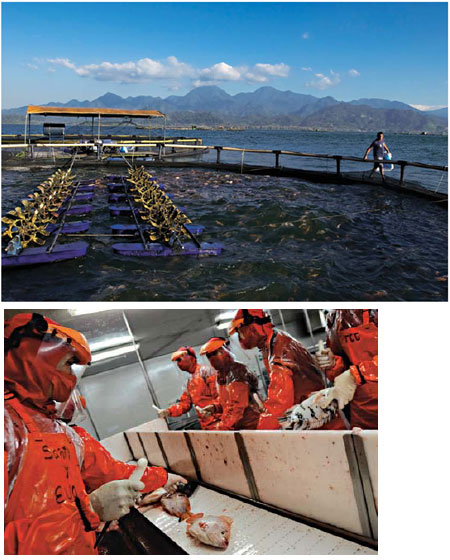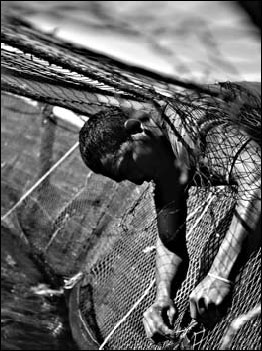Society
A global fish and its dark side
Updated: 2011-05-15 08:00
By Elisabeth Rosenthal (New York Times)
|
The farming of tilapia, also known as "aquatic chicken," can ruin a lake's ecosystem. Regal Springs, one of the largest producers of farmed tilapia, raises the fish in modules on Lake Yojoa in Honduras, top. Regal Springs workers, above, process tilapia. Tilapia can wind up on plates in the United States 12 hours after being harvested in Central America. Photographs by Meridith Kohut for The New York Times |
|
As fish dwindle, tilapia grows in importance. Cages in Honduras. Meridith Kohut for The New York Times |
The success of tilapia may pose threats to health and ecology
Agua Azul, Honduras
Acommon Bible story says Jesus fed 5,000 people with five loaves and two fish, which scholars surmise were tilapia.
But at the Aquafinca fish farm here, a modern miracle takes place daily: Tens of thousands of beefy, flapping tilapia are hauled out of teeming cages on Lake Yojoa, converted to fillets in a cold slaughterhouse and rushed onto planes bound for the United States, where some will appear on plates within 12 hours.
Americans ate 215 million kilograms of tilapia last year, four times the amount a decade ago, making this once obscure African native the most popular farmed fish in the United States.
Although wild fish predominate in most species, a vast majority of the tilapia consumed is "harvested" from pens or cages in Latin America and Asia.
Known in the food business as "aquatic chicken" because it breeds easily and tastes bland, tilapia is the perfect factory fish; it happily eats pellets made largely of corn and soy and gains weight rapidly, easily converting a diet that resembles cheap chicken feed into low-cost seafood.
"Ten years ago no one had heard of it; now everyone wants it because it doesn't have a fishy taste, especially hospitals and schools," said Orlando Delgado, general manager of Aquafinca.
Farmed tilapia is promoted as good for your health and for the environment at a time when many marine stocks have been seriously depleted.
Compared with other fish, though, farmed tilapia contains relatively small amounts of beneficial omega-3 fatty acids, the fish oils that are the main reasons doctors recommend eating fish frequently; salmon has more than 10 times the amount of tilapia. "It may look like fish and taste like fish but does not have the benefits - it may be detrimental," said Dr. Floyd Chilton, a professor of physiology and pharmacology at Wake Forest Baptist Medical Center who specializes in fish lipids in Winston-Salem, North Carolina.
Environmentalists argue that unregulated tilapia farming is damaging ecosystems in poor countries.
Defenders of tilapia aquaculture point out that this young and rapidly growing industry has begun improving standards. The Aquaculture Stewardship Council, a creation of the W.W.F. conservation body and I.D.H., a Dutch sustainable trade program, is rolling out an inspection program for tilapia farms. Those that pass will receive labels identifying their fish as "responsibly farmed." Aquafinca has became the first to pass an initial inspection.
Proponents say tilapia aquaculture will only grow because it provides food and jobs in a world of declining fish stocks and rising population. "There are going to be more farmed fish each year," said Kevin Fitzsimmons, a biologist at the University of Arizona. "Think about it: if we tried to get beef from hunting, there would be a lot of hungry people."
Native to African lakes, tilapia was deployed in many poor tropical countries in the second half of the 20th century to control weeds and mosquitoes. This "maybe was not the best idea," said Aaron McNevin, a biologist for the W.W.F. who is working on standards for tilapia farms, because tilapia "is one of the most invasive species known and very hard to get rid of once they are established."
By the 1990s, businesses saw opportunity in farming this hearty species. Using selective breeding, scientists created today's industrial strains: big, fleshy fish with tiny heads and tails, and intestines that allow them to absorb food faster.
Farmed tilapia reaches its sales weight of about a kilogram in roughly nine months of intensive feeding.
For shoppers picking up tilapia from China or Honduras or Ecuador, there is little guidance. "It's such a complicated job for consumers to decide what to eat, with aquaculture production expanding so rapidly," said Peter Bridson, aquaculture research manager of the Monterey Bay Aquarium in California. The aquarium produces the popular Seafood Watch, an independent consumer guide to buying sustainable fish.
For the moment, Seafood Watch lists tilapia raised in the United States as a "best choice," tilapia from Latin America as a "good alternative" and tilapia from China as "to be avoided." Dr. Bridson said these rough ratings were largely based on the presence of effective monitoring in those places and how farms disposed of their waste.
But many biologists worry that the big business of tilapia farming will outweigh caution, leaving dead lakes and extinct species. Dr. Jeffrey McCrary, a fish biologist, has spent the past decade studying how a small, short-lived tilapia farm degraded Lake Apoyo in Nicaragua. "One small cage screwed up the entire lake - the entire lake!" he said of the farm, which existed from 1995 to 2000.
Waste from the cages polluted the pristine ecosystem, and some tilapia escaped. An aquatic plant called charra, an important food for fish, disappeared, leaving the lake a wasteland. Today, some species of plants and fish are slowly recovering, but others are probably gone forever, said Dr. McCrary, who works for the Nicaraguan foundation FUNDECI.
Dr. Salvador Montenegro, director of Nicaragua's Center for Aquatic Resource Investigation, has spent a decade fighting to close the Nicanor tilapia farm in Lake Nicaragua, saying it "jeopardizes a lake that is a national treasure." Weaker fish, like the rainbow bass, have been disappearing from the lake.
But David Senna, Nicanor's manager, said the company's cages occupied only a tiny fraction of the lake, in an area with strong currents sufficient to carry away fish waste. He noted that tilapia were introduced to Lake Nicaragua in the 1980s, "so if they're going to take over, it was already doomed."
The Mayo Clinic, an American medical research group, advises patients that tilapia does not "appear to be as heart-healthy." And much of the tilapia on the world's markets comes from China.
China exports the fish frozen and packed in carbon monoxide to preserve color and appear fresh once thawed for retail sale.
"People wanted to pay $3.99 a pound for this frozen stuff rather than $5.99 for fresh, especially during the recession," said Mr. Senna, the manager of Nicanor. Chinese fish farms are regarded as poorly regulated, Dr. Bridson said, which is why the industry needs clearer standards for sustainable fish farming and consumer labeling. Until then, the cheapest product is poised to win.
"If I have 100 tilapia in a pond, I may have happy tilapia because they have room to swim, but I won't be able to sell them since I won't get access to the global market," Dr. McCrary said, adding that "there's no tilapia equivalent of free-range chicken."
The New York Times
Specials

The song dynasty
There are MORE THAN 300 types of Chinese operas but two POPULAR varieties are major standouts

Sino-US Dialogue
China and the US hold the third round of the Strategic and Economic Dialogue from May 9-10 in Washington.

Building communities
American architect John Portman and his company have developed more than 30 projects across China.

